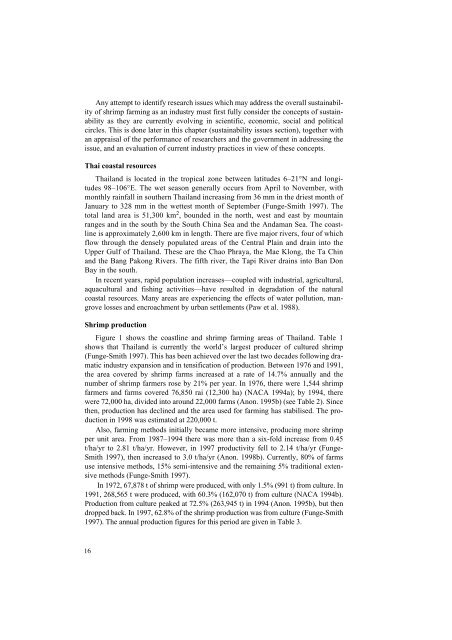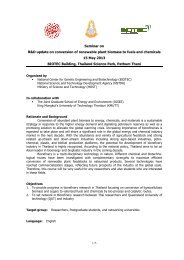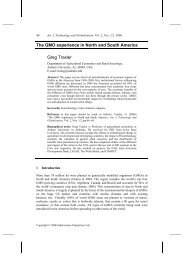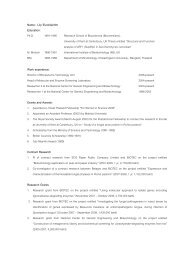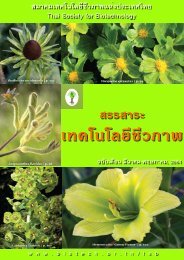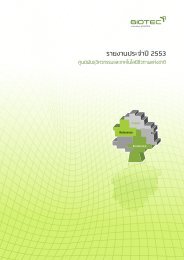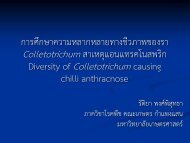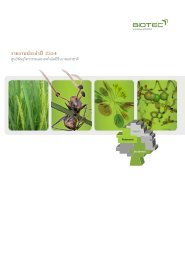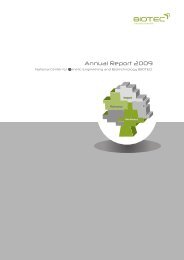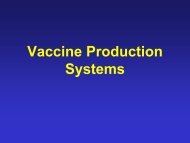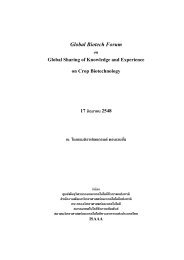Coastal Shrimp Aquaculture in Thailand: Key Issues for Research
Coastal Shrimp Aquaculture in Thailand: Key Issues for Research
Coastal Shrimp Aquaculture in Thailand: Key Issues for Research
You also want an ePaper? Increase the reach of your titles
YUMPU automatically turns print PDFs into web optimized ePapers that Google loves.
!Any attempt to identify research issues which may address the overall susta<strong>in</strong>abilityof shrimp farm<strong>in</strong>g as an <strong>in</strong>dustry must first fully consider the concepts of susta<strong>in</strong>abilityas they are currently evolv<strong>in</strong>g <strong>in</strong> scientific, economic, social and politicalcircles. This is done later <strong>in</strong> this chapter (susta<strong>in</strong>ability issues section), together withan appraisal of the per<strong>for</strong>mance of researchers and the government <strong>in</strong> address<strong>in</strong>g theissue, and an evaluation of current <strong>in</strong>dustry practices <strong>in</strong> view of these concepts.Thai coastal resources<strong>Thailand</strong> is located <strong>in</strong> the tropical zone between latitudes 6–21°N and longitudes98–106°E. The wet season generally occurs from April to November, withmonthly ra<strong>in</strong>fall <strong>in</strong> southern <strong>Thailand</strong> <strong>in</strong>creas<strong>in</strong>g from 36 mm <strong>in</strong> the driest month ofJanuary to 328 mm <strong>in</strong> the wettest month of September (Funge-Smith 1997). Thetotal land area is 51,300 km 2 , bounded <strong>in</strong> the north, west and east by mounta<strong>in</strong>ranges and <strong>in</strong> the south by the South Ch<strong>in</strong>a Sea and the Andaman Sea. The coastl<strong>in</strong>eis approximately 2,600 km <strong>in</strong> length. There are five major rivers, four of whichflow through the densely populated areas of the Central Pla<strong>in</strong> and dra<strong>in</strong> <strong>in</strong>to theUpper Gulf of <strong>Thailand</strong>. These are the Chao Phraya, the Mae Klong, the Ta Ch<strong>in</strong>and the Bang Pakong Rivers. The fifth river, the Tapi River dra<strong>in</strong>s <strong>in</strong>to Ban DonBay <strong>in</strong> the south.In recent years, rapid population <strong>in</strong>creases—coupled with <strong>in</strong>dustrial, agricultural,aquacultural and fish<strong>in</strong>g activities—have resulted <strong>in</strong> degradation of the naturalcoastal resources. Many areas are experienc<strong>in</strong>g the effects of water pollution, mangrovelosses and encroachment by urban settlements (Paw et al. 1988).<strong>Shrimp</strong> productionFigure 1 shows the coastl<strong>in</strong>e and shrimp farm<strong>in</strong>g areas of <strong>Thailand</strong>. Table 1shows that <strong>Thailand</strong> is currently the world’s largest producer of cultured shrimp(Funge-Smith 1997). This has been achieved over the last two decades follow<strong>in</strong>g dramatic<strong>in</strong>dustry expansion and <strong>in</strong> tensification of production. Between 1976 and 1991,the area covered by shrimp farms <strong>in</strong>creased at a rate of 14.7% annually and thenumber of shrimp farmers rose by 21% per year. In 1976, there were 1,544 shrimpfarmers and farms covered 76,850 rai (12,300 ha) (NACA 1994a); by 1994, therewere 72,000 ha, divided <strong>in</strong>to around 22,000 farms (Anon. 1995b) (see Table 2). S<strong>in</strong>cethen, production has decl<strong>in</strong>ed and the area used <strong>for</strong> farm<strong>in</strong>g has stabilised. The production<strong>in</strong> 1998 was estimated at 220,000 t.Also, farm<strong>in</strong>g methods <strong>in</strong>itially became more <strong>in</strong>tensive, produc<strong>in</strong>g more shrimpper unit area. From 1987–1994 there was more than a six-fold <strong>in</strong>crease from 0.45t/ha/yr to 2.81 t/ha/yr. However, <strong>in</strong> 1997 productivity fell to 2.14 t/ha/yr (Funge-Smith 1997), then <strong>in</strong>creased to 3.0 t/ha/yr (Anon. 1998b). Currently, 80% of farmsuse <strong>in</strong>tensive methods, 15% semi-<strong>in</strong>tensive and the rema<strong>in</strong><strong>in</strong>g 5% traditional extensivemethods (Funge-Smith 1997).In 1972, 67,878 t of shrimp were produced, with only 1.5% (991 t) from culture. In1991, 268,565 t were produced, with 60.3% (162,070 t) from culture (NACA 1994b).Production from culture peaked at 72.5% (263,945 t) <strong>in</strong> 1994 (Anon. 1995b), but thendropped back. In 1997, 62.8% of the shrimp production was from culture (Funge-Smith1997). The annual production figures <strong>for</strong> this period are given <strong>in</strong> Table 3.)%


